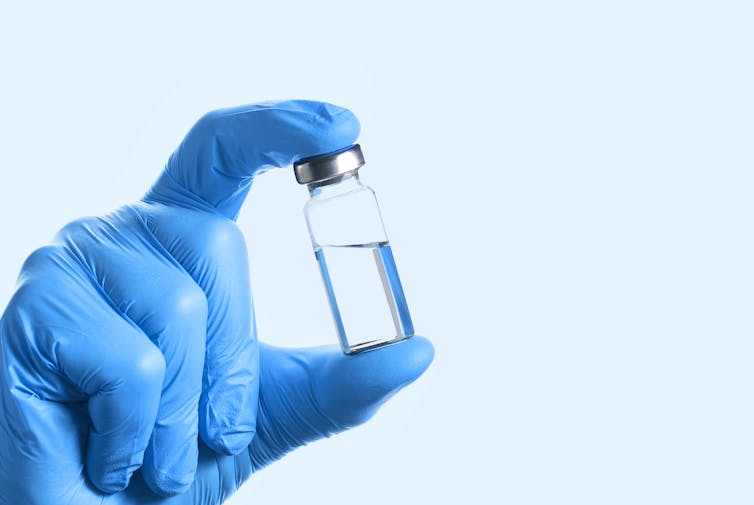Yuganov Konstantin/Shutterstock
The Oxford/AstraZeneca vaccine is effective at preventing people from developing COVID-19 and could reduce viral transmission, according to a new scientific paper from the team behind the vaccine.
The paper also suggests that delaying the second dose to 12 weeks after the first works especially well. The protective effect of the first dose doesn’t appear to wane during these 12 weeks, and leaving a longer gap between doses ultimately seems to make the second more protective.
These promising new findings come from an analysis of clinical trial data, updating a previous paper on the vaccine’s trial results published in early December. However, it’s important to keep in mind that the paper is a preprint – meaning its results haven’t yet been scrutinised formally by other scientists.
The main difference between this paper and the last is that more cases of COVID-19 have been included. In the December paper, 192 cases of illness were included in the analysis, enough to give a general estimate of the amount by which the vaccine reduces the risk of developing symptomatic COVID-19 – otherwise known its efficacy. This new paper analyses 332 cases.
More cases appearing among trial participants doesn’t mean the vaccine isn’t working as well. As before, the majority occurred in those who didn’t get the vaccine, meaning its overall efficacy is broadly the same: 67% (still lower than other authorised COVID-19 vaccines, but nevertheless offering important protection).
Rather, having more cases to look at means the authors can now make more robust estimates of the vaccine’s efficacy. It’s also allowed them to address the dosing regimen, whether the vaccine prevents asymptomatic infection and how protective a single dose actually is.
The half-dose debate
One surprising trial outcome reported in the earlier paper was that efficacy seemed to be much higher in volunteers given only half a dose in their first injection. The half-dosing was apparently an error and so was considered to be a serendipitous mistake. In the UK part of the trial, giving two standard doses resulted in 59% efficacy, whereas the efficacy of a half dose followed by a standard dose was 90%.
In an earlier Conversation article, I raised concerns about the reliability of any conclusions drawn on starting with a half-dose. The UK Medicines and Health Products Regulatory Agency licensed the standard-dosing schedule, saying that when assessing the data, the benefits of the initial half-dose “were not borne out by the full analysis”.

Soho A Studio/Shutterstock
It’s very clear in this second paper that the dosing error was not serendipitous at all. Rather, the greater efficacy for those receiving an initial half-dose appears to be down to many of them receiving their second injection much later.
This new analysis shows that vaccine efficacy after the second dose was only 55% if the gap between doses was less than six weeks, but was 81% if the gap was 12 weeks or more. Although not directly presented in the paper, it appears that with a 12-week gap between doses there was very little difference in efficacy for those receiving an initial half or full dose.
Mind the gap
One of the more intense debates around the UK vaccine rollout has concerned increasing the gap between doses to 12 weeks. The thinking was that although a single injection may not be as protective as two, delaying the second dose would allow more people to be given some protection with the first, leading to fewer deaths.
In light of this, this paper also looks at the efficacy of a single injection of the Oxford/AstraZeneca vaccine. Of course, this is only relevant to people receiving this vaccine. Anyone receiving the Pfizer/BioNTech or Moderna vaccines in the UK will also have their doses spaced out by 12 weeks, but we don’t have a clear view yet of what effect – if any – this has on these vaccines’ efficacy.
From 22 days after being given, the paper states that the efficacy of the first dose of the Oxford/AstraZeneca vaccine is 76%. The paper also finds no evidence of efficacy declining during the 90 days following the first injection – meaning a first dose should remain protective until the second is given 12 weeks later.
At first sight, it appears that a single-dose regimen may even provide better protection than two doses (76% vs 63%). However, the confidence intervals for these figures overlap, meaning that in reality these results may not be that different.
Indeed, overall we need to be a little cautious here. Testing the vaccine’s efficacy after delaying the second dose for different amounts of time wasn’t an original aim of the trial. This means that people weren’t randomly assigned how long they would have to wait for their second dose to eliminate potential bias.
Because of this, it could be that these findings have been influenced by other factors.
Preventing transmission?
One aspect of this paper picked up by the media is the suggestion that the vaccine could substantially cut the spread of the virus. However, we also have to be somewhat cautious with accepting this conclusion.
As well as recording symptomatic infections, the authors also took regular throat swabs for PCR testing to see what effect the vaccine had on asymptomatic infections. The overall efficacy at preventing symptomatic infections after two standard doses was 67%, but for preventing any infection (as measured by a positive PCR test) it was 50% – a worthwhile reduction, but not enough to prevent all transmission.
Any vaccine that reduces the incidence of symptomatic infections will also reduce the transmission of the virus somewhat. But people with asymptomatic infections can still spread the virus, albeit rather less effectively. So unless a vaccine is highly effective at preventing these, it won’t be able to fully prevent the disease spreading.
And, as others have noted, seeing a reduction in the number of people carrying the virus as a result of being vaccinated doesn’t definitively prove that it will reduce transmission – this is still quite a big inference to make.
![]()
Paul Hunter consults to The World Health Organisation. He receives funding from National Institute for Health Research, World Health Organization and The European Regional Development Fund.











